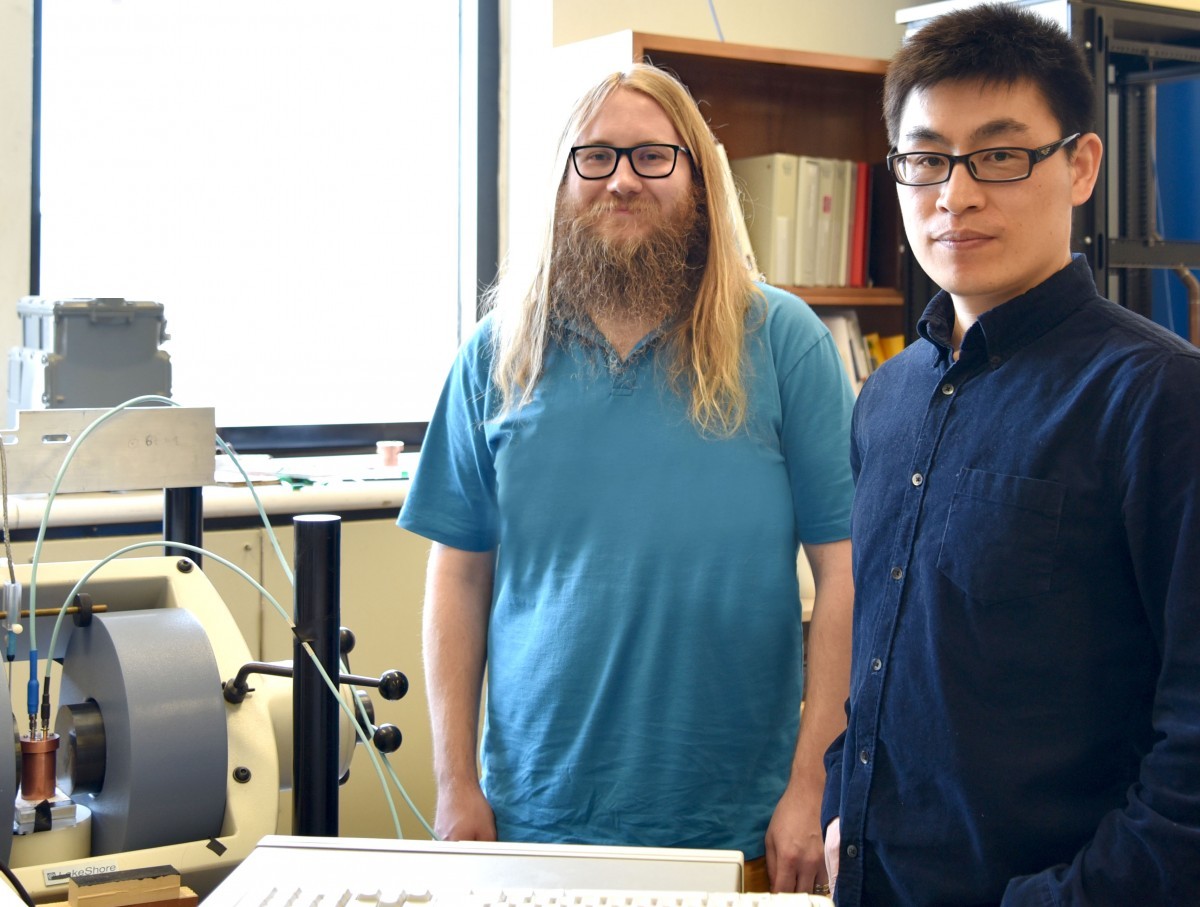
From L to R: Michael Harder and Lihui Bai, department of Physics and Astronomy
Graduate students’ introduce world to cutting-edge field of study: cavity spintronics
Lihui Bai and Michael Harder have been developing a new groundbreaking field of study within condensed matter physics, which they have termed, “cavity spintronics.” Their research combines cavity quantum electrodynamics (QED) and spintronics, two important fields that are driving the rapid development of the next generation of electronic technology and quantum computing.
Their paper, “Spin Pumping in Electrodynamically Coupled Magnon-Photon Systems”, published in the prestigious journal, Physical Review Letters (PRL), presents experimental and theoretical findings that add a new stone to the foundation of cavity spintronics. Their work challenges competitive research teams in the field at Yale University, Tokyo University and Walther-Meißner-Institut in München.
“We are very proud that our students are at the frontiers of this exciting new field of physics. Our students are proving that there is just as much opportunity here at the U of M to make a significant difference within their chosen fields, as they would have at any other top universities across the globe,” said Stefi Baum, Dean of Science.
Harder and Bai are the first to demonstrate to the condensed matter physics community the intriguing relationship between quantum and classical physics in cavity spintronics. Experiments performed in the past two years were understood only in terms of quantum mechanics. Harder and Bai suggest this understanding might need to be revised as it can be understood using classical physics. They are also the first to introduce a new practical method to control spin current by using light-matter interaction.
The work has received distinct recognition from the editors of Physical Review Letters, who have selected their paper as an Editor’s Suggestion, is highlighted in a 2-page featured viewpoint in “Physics,” and it has also received high appreciation from their competitors.
“It is really a beautiful piece of work and will be highly appreciated by the community,” said Dr. Hans-Gregor Hübl from the Walther-Meißner-Institut in Germany.
This is the second time Harder has published an article in the Physical Review Letters and received the distinction of Editor’s Suggestion. Previously, he published a paper in 2011, based on his undergraduate honours thesis research work, which he also completed in the department of physics & astronomy at the University of Manitoba.
Harder grew up in Steinbach, Manitoba where he developed an interest in physics during high school. He graduated with a bachelor of science degree in physics from the University of Manitoba and went on to pursue his master’s at University of Victoria.
He initially began his Ph.D. at the University of Victoria; however he soon returned to Winnipeg to work with the team at the U of M.
“The expertise in condensed matter physics was here at University of Manitoba; it wasn’t something that I could find anywhere else,” said Harder, who is now working on his Ph.D. in the department of physics and astronomy alongside Prof. Can-Ming Hu and the spintronics group.
Upon the recommendation of professor Hu, Harder is currently in Germany completing a three-month, Natural Sciences and Engineering Research Council (NSERC) visiting scholarship, where he is initiating collaboration with their rival team of experts led by Hans-Gregor Hübl.
Bai, originally from China, also studied at the University of Manitoba. In June 2008, he completed a joint Ph.D., from the University of Manitoba and Fudan University in Shanghai, China. He went on to work in Japan as a research fellow at Tohoku University, but in 2012, he chose to return to the University of Manitoba as a research associate, despite receiving multiple offers from various leading institutes throughout the world.
The work of Harder and Bai in the spintronics group at U of M builds on the shoulders of a few giants in two different fields.
In the field of spintronics, Albert Fert and Peter Grunberg, who received the Nobel Prize in Physics in 2007 for their discovery of Giant Magnetoresistance, introduced the first practical application of spintronics physics. This discovery revolutionized techniques for retrieving data from a hard disk, one of the first major applications of nanotechnology. It has led to the recent applications of, who received the Nobel Prize in Physics in 2012, pioneered the development of cavity methods for measuring and manipulating individual particles while preserving their quantum-mechanical nature. This development enabled their field of research to take the very first steps towards building a new type of super fast computer, based on quantum physics.
“Lihui and Michael’s work takes both fields forward in a merged new direction. Working with such talented students, watching and helping them to make distinct contributions to an emerging field, I feel very lucky and satisfying,” says Hu. The department of physics and astronomy has a long-standing great reputation in research, both in Canada and internationally. Every year, we attract very bright students to join our diverse graduate and undergraduate programs. Lihui’s and Michael’s story is just one example of many of our students who are launching their science careers from this place.”
Research at the University of Manitoba is partially supported by funding from the Government of Canada Research Support Fund.






